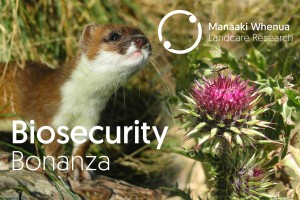In this section
-
Events
- LinkOnline Webinar Series
- Link Seminars
- NZ Garden Bird Survey
- Biosecurity Bonanza 2025
- Applications of LiDAR: insights from the Hawke’s Bay Regional Council and MWLR partnership programme
- More Birds in the Bush - End of programme event
- Te Tiriti-guided national DNA reference library wānanga series
- Remote sensing webinar series 2023
- Remote sensing webinar series 2022
- Fieldays 2023
- Fieldays 2022
- Molecular biology
- E Tipu - Boma Agri Summit
- TechWeek 2019
- Conservation Week Livestreams
- Kia Manawaroa Kia Puawai: Enduring Māori Livelihoods webinar
- Kōrero: Resource Management reforms
- STEMFEST 2023
Find out about the latest biosecurity research being undertaken at the Bioeconomy Science Institute, Manaaki Whenua – Landcare Research Group.
Join our scientists from across the motu as they share fresh insights and updates on weed control, invasive pest control, and other cutting-edge biosecurity research.
This is your chance to hear directly from the experts, ask questions, and learn how science is helping to protect Aotearoa New Zealand’s unique biodiversity.
These webinars are free to attend – register today and be part of the 2025 Biosecurity Bonanza!
Agenda
Scroll down to register
| Session date & time | Title | Presenter/Presenters |
|---|---|---|
| Monday 6 October 10-10.30am |
Remote sensing for invasive weed management | Paul Peterson |
| Monday 6 October 1-1.30pm |
The Forgotten Costs of Rabbits — and the Economic Power of Research | Mandy Barron |
| Tuesday 7 October 10-10.30am |
The Nationally Significant Collections & Databases supporting biosecurity | Bevan Weir |
| Tuesday 7 October 1-1.30pm |
Removing the last 1% of a mainland predator population: evaluating a novel approach | Graham Hickling |
| Wednesday 8 October 10-10.30am |
Wilding conifers reinvade despite control efforts, while native plants fail to thrive | Jennifer Bufford |
| Wednesday 8 October 1-1.30pm |
Cats protecting birds: Non-lethal tools for urban cat management | Patrick Garvey |
| Thursday 9 October 10-10.30am |
Reactive or adaptive? Cost-efficient invasive species management | Dean Anderson |
| Thursday 9 October 1-1.30pm |
Anticipating Aotearoa’s weedy future | Angela Brandt |
| Friday 10 October 10-10.30am |
Browsing impacts of on native alpine vegetation | Amy Whitehead & Laureline Rossignaud |
| Friday 10 October 1-1.30pm |
Biocontrol of Weeds in the Pacific | Indigo Michael & Zane McGrath |
The Forgotten Costs of Rabbits — and the Economic Power of Research
 Monday 6 October, 1-1.30pm
Monday 6 October, 1-1.30pm
Mandy Barron
Rabbits are a serious economic and environmental pest in dryland ecosystems across Aotearoa-New Zealand. Their numbers and impacts are expected to grow under climate change and with increasing immunity to Rabbit Haemorrhagic Disease Virus (RHDV). Despite these substantial current and future costs, we lack a coordinated and effective approach to rabbit management resulting in piecemeal rabbit control and the use of inappropriate methods that potentially jeopardise future control efforts e.g. through induction of bait shyness. We argue that cost-effective rabbit management requires sustained investment in collaborative research to scope the problem and identify and trial new solutions. We will also talk about changing rabbit population – disease dynamics and some new work to monitor which RHDV strains are circulating in the landscape.
Register now
Removing the last 1% of a mainland predator population: evaluating a novel approach
 Tuesday 7 October, 1-1.30pm
Tuesday 7 October, 1-1.30pm
Graham Hickling
Predator eradication programmes fail, in part, because bait-shy and trap-shy individuals evade traditional control measures. Our previous research has shown, however, that these shy individuals are still willing to cautiously sample novel baits and lures - although their caution leads to sublethal dosing and failure to trigger traps. Recently, we tested the hypothesis that pre-feed baits containing a central nervous system (CNS) stimulant can trigger reward-seeking behaviours that overcome shyness. For the approach to be practical, several criteria need to be met: the stimulant needs to be stable in a cereal or paste matrix; the pre-feed is palatable; and a short series of exposures to pre-feed will increase the target species’ behavioural drive. This presentation summarizes tests of three potent CNS stimulants on the responses of ship rats and brushtail possums to control devices.
Register now
Cats protecting birds: Non-lethal tools for urban cat management
 Wednesday 8 October, 1-1.30pm
Wednesday 8 October, 1-1.30pm
Patrick Garvey
Cats are a major driver of biodiversity decline, yet lethal management is often neither feasible nor desirable in urban environments. Our MBIE project developed a non-lethal tool based on the “ecology of fear” that showed predator auditory cues - especially cat vocalisations - can significantly alter urban cat movements. We conducted surveys in Auckland, Wellington, and Christchurch that documented cat incursions into reserves and their impacts on nesting birds. Through a series of captive and field experiments, we discovered that auditory playbacks could manipulate cat behaviour for conservation, as we reduced cat detections across all reserves by 30% and foraging time by up to 80%. Alongside our ecological studies, we carried out social research with Zealandia’s ‘halo’ community to explore the complexities of managing cats and identified practical strategies to encourage responsible ownership. Building on this research, we are now focusing on the Ashley Rakahuri braided river, where we will integrate ecological studies with social perspectives to manage risks to native birds. Our programme highlights how non-lethal approaches, such as auditory playbacks and cat containment, can provide practical, humane solutions to mitigate the impacts of urban cats.
Register now
Reactive or Adaptive? Cost-efficient invasive species management
 Thursday 9 October. 10-10.30am
Thursday 9 October. 10-10.30am
Dean Anderson
Environmental management strategies are widely expected to be guided by robust scientific research. Adaptive management, first articulated in the late 1970s and 1980s, provides a framework for embedding research within management implementation and experimentation. In principle, this iterative cycle can improve understanding of ecological systems while delivering more cost-efficient outcomes. Despite its enduring appeal, real-world examples of adaptive management remain rare. In this talk, I review cases from New Zealand where adaptive approaches have been applied to invasive species management, and highlight opportunities where reactive or short-term responses prevailed instead. I evaluate the costs, risks, and benefits of adaptive approaches, and examine the institutional and professional constraints that continue to impede their adoption. I argue that stronger management-science partnerships are essential if adaptive management is to move beyond rhetoric. Environmental managers have an obligation to funders to maximise the use of science, while applied scientists have a parallel responsibility to frame and pursue research questions that feed back into more effective and efficient invasive species management.
Register now
Browsing impacts on native alpine vegetation
 Friday 10 October, 10-10.30am
Friday 10 October, 10-10.30am
Amy Whitehead & Laureline Rossignaud
Introduced browsing mammals are considered both a valued resource and a management challenge in Aotearoa New Zealand’s alpine environments. Himalayan tahr, in particular, support recreational hunting but also affect the condition and composition of native vegetation. Three decades of monitoring provide a rare opportunity to understand these long-term impacts and assess whether current management thresholds are sufficient to maintain ecosystem integrity. Using tahr as an example, we show the value of long-term monitoring for guiding adaptive wildlife management and balancing conservation outcomes with stakeholder expectations in New Zealand’s alpine environments.
Register now
Remote sensing for invasive weed management
 Monday 6 October, 10-10.30am
Monday 6 October, 10-10.30am
Paul Peterson
In this talk, we present a remote sensing mapping method to assess impacts of a weed control programme on invasive, ecosystem-altering, legumes on the Central Plateau, North Island. To help counter this threat, the Desert Road Invasive Legume Control Group (DRILCG) was formed in 2012 and includes an unusually diverse range of stakeholders: Department of Conservation, NZ Defence Force, Ngā Waihua o Paerangi, Transpower, Genesis Energy, Horizons Regional Council, Waikato Regional Council, and the Lake Rotoaira Forest Trust. The DRILCG funded high-resolution aeroplane imagery during the flowering of invasive gorse (Ulex europaeus), broom (Cytisus scoparius) and tree lupin (Lupinus arboreus) over a 23,000 ha area. Resulting imagery was cut into 200 x 200 m grids and the target weeds manually scored as zero, low, medium or high density. Change maps, produced from repeat imagery, helped assess the impacts of herbicide operations, enabling recommendations for more targeted and sustainable landscape-scale management strategies such as focussing on outlying populations. This study demonstrates how a remote sensing method using RGB (visible light) imagery can produce cost-effective weed mapping solutions for informing management decisions.
Register now
The Nationally Significant Collections & Databases supporting biosecurity
 Tuesday 7 October, 10-10.30am
Tuesday 7 October, 10-10.30am
Bevan Weir
The Manaaki Whenua group of the Bioeconomy Science Institute has several ‘nationally significant’ collections of plants, invertebrates, fungi, and microbes. These collections provide a critical role in supporting biosecurity research and operational activities in New Zealand. In this talk, various case studies will be presented showing the utility of these comprehensive, well-curated, data-rich collections with specimens dating from early European exploration of the country.
Register now
Wilding conifers reinvade despite control efforts, while native plants fail to thrive
 Wednesday 8 October, 10-10.30am
Wednesday 8 October, 10-10.30am
Jennifer Bufford
Wilding conifers are some of most widespread and abundant invasive plants of conservation land in Aotearoa New Zealand. Pinus contorta has been controlled for decades, but pine reinvasion has not been measured. We measured reinvasion and native plant communities in sites controlled for pines across a range of habitats and climates. After dense invasions, conifers reinvaded quickly and native plant cover was low, even after a decade since control, and did not improve over time. Other wilding conifers, particularly Douglas fir, were commonly observed, raising concerns about the future of these plant communities and highlighting the need for adaptive, repeated management of invasive conifers.
Register now
Anticipating Aotearoa’s weedy future to best support changing needs for management
Thursday 9 October 1-1.30pm
Angela Brandt
 Aotearoa New Zealand is already struggling under the weight of weeds, and the problem is only likely to worsen in future. We expect new weeds to emerge, and that environmental and social change will exacerbate weed invasion. With a range of collaborators, we have identified research priorities and management needs that are likely to arise under four possible future scenarios: 1) increased Māori land tenure, 2) widespread native afforestation, 3) the success of Predator Free 2050, and 4) increasing extreme weather events. We found that unique research is needed to address each scenario, but also that emergent research priorities and needed management tools would provide benefit in any weedy future.
Aotearoa New Zealand is already struggling under the weight of weeds, and the problem is only likely to worsen in future. We expect new weeds to emerge, and that environmental and social change will exacerbate weed invasion. With a range of collaborators, we have identified research priorities and management needs that are likely to arise under four possible future scenarios: 1) increased Māori land tenure, 2) widespread native afforestation, 3) the success of Predator Free 2050, and 4) increasing extreme weather events. We found that unique research is needed to address each scenario, but also that emergent research priorities and needed management tools would provide benefit in any weedy future.
Register now
Advancing weed biocontrol for ecosystem resilience in the Pacific: efforts to manage African tulip tree and prickly solanum
 Friday 10 October, 1-1.30pm
Friday 10 October, 1-1.30pm
Indigo Michael & Zane McGrath
Invasive weeds continue to pose serious threats to biodiversity, agriculture, and ecosystem resilience across the Pacific. We discuss two ongoing biocontrol programmes under the Natural Enemies – Natural Solutions programme targeting African tulip tree (Spathodea campanulata) and prickly solanum (Solanum torvum). African tulip tree is considered among the world’s 30 worst terrestrial invaders and is a major problem in most non-atoll countries across the Pacific, including Tonga, Cook Islands, Samoa, Fiji, and Vanuatu. Prickly solanum is a serious agricultural weed with major impacts in countries such as Vanuatu, where cattle farming is a vital livelihood. Its spread has been directly linked to reduced pasture quality and a documented decline in cattle numbers. Huge efforts have been made in the last decade to develop, release, and monitor biocontrol agents to manage these invasive weeds. Together, these programmes represent a critical step toward protecting Pacific livelihoods, restoring ecosystems, and building long-term resilience against invasive species.
Register now
Presenters

Mandy Barron

Jennifer Bufford

Patrick Garvey

Graham Hickling

Zane McGrath

Indigo Michael

Paul Peterson

Bevan Weir











